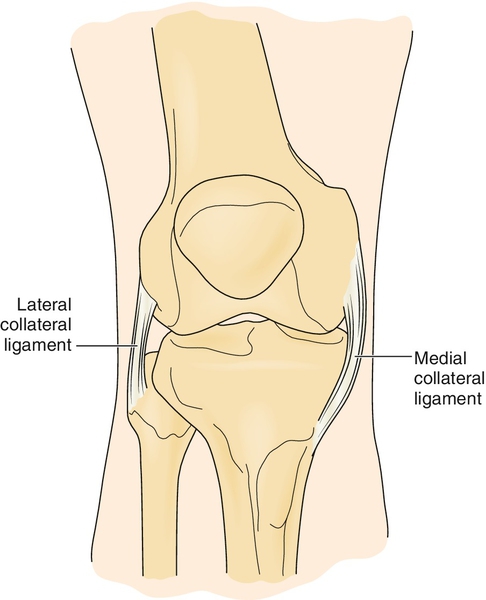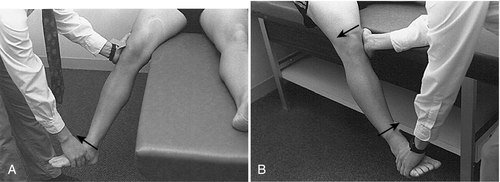CHAPTER 66
Collateral Ligament Sprain
Paul Lento, MD; Venu Akuthota, MD
Definition
The medial collateral ligament (MCL) and lateral collateral ligament (LCL) are important structures that predominantly prevent valgus and varus forces, respectively, through the knee (Fig. 66.1). Like other ligamentous injuries, knee collateral ligament sprains can be defined by three grades of injury. With a grade I sprain, there is localized tenderness without frank laxity. Anatomically, only a minimal number of fibers are torn. On physical examination, the joint space opens less than 5 mm (i.e., 1 + laxity). With a moderate, or grade II, sprain, there is more generalized tenderness without frank laxity. Grade II sprains can cover the gamut from a few fibers torn to nearly all fibers torn [1]. The joint may gap 5 to 10 mm (i.e., 2 + laxity) when force is applied. A severe, or grade III, sprain, by definition, is a complete disruption of all ligamentous fibers with a joint space gap of more than 10 mm (i.e., 3 + laxity) on stressing of the ligament [2].

Medial Complex Injury and Resultant Instability
The MCL is the most commonly injured ligament of the knee [3]. In fact, injury to this structure has been estimated to occur in 0.24 per 1000 people in the United States in any given year and to be twice as high in males (0.36) compared with females (0.18) [4]. This ligament is usually injured when valgus forces are applied to the knee [5]. Contact injuries produce grade III MCL deficits; noncontact MCL injuries typically result in lower grade injuries. Although MCL injury can occur in isolation, valgus forces typically instigate injury to other medial structures [6]. Findings of a rotational component to medial joint instability should prompt a search for cruciate ligament, meniscal, or posterior oblique ligament involvement [7,8].
Lateral Complex Injury and Resultant Instability
The LCL is much less frequently injured than the MCL. True isolated injury to the LCL is rare. True straight lateral instability requires a large vector force. Thus, a complete knee dislocation with possible damage to neurovascular structures should be suspected if straight lateral instability is present [9]. Posterolateral rotatory instability appears to be a more frequent cause of lateral instability than of straight lateral instability. Most authors believe that posterolateral rotatory instability requires disruption of the arcuate complex, the posterior cruciate ligament, and the LCL. The usual mechanism of posterolateral rotatory instability is forcing of the knee into hyperextension and external rotation [6,9].
Symptoms
Medial or lateral knee pain is the most common symptom related to knee collateral ligament injury. Interestingly, grade I and grade II injuries cause more pain than grade III injuries do [3,10]. Pain is often accompanied by a sensation of knee locking [8]. This may be due to hamstring muscle contraction or concomitant meniscal injury. Patients may also report an audible pop, although this is more common with anterior cruciate ligament injuries [3]. A giving way sensation or a feeling of instability is often reported with high-grade injuries. Moreover, patients with high-grade injuries may also have neurovascular damage [11]. Therefore these individuals may complain of a loss of sensation or muscle strength below the level of the knee [9].
Physical Examination
Physical examination begins with the uninjured knee to obtain a baseline. Palpatory examination can be as important as ligamentous laxity testing. Palpation can reveal tenderness along the length of the collateral ligament, localized swelling, or a tissue defect [8]. Localized swelling correlates well with the area of injury to the MCL [10]. With pure joint line tenderness, an underlying meniscal injury should be suspected. A true knee joint effusion may also be present with collateral ligament injuries; however, it is more prevalent with meniscal or cruciate ligament injury [12].
Laxity of the medial joint ligaments is determined by the abduction stress test (Fig. 66.2A), performed by examination of the knee at 0 and 30 degrees of joint flexion. If the test result is negative, a firm endpoint will be reached. If the test result is grossly positive, the femur and tibia will gap with valgus stress and “clunk” back when the stress is removed [13]. Although it is controversial, increased medial joint laxity of the fully extended knee with a valgus force not only implies damage to the superficial and deep fibers of the MCL but also indicates rupture of the posterior cruciate ligament or posterior oblique ligament [14–16]. If laxity occurs at 30 degrees of flexion but not at 0 degrees, one may confidently conclude that MCL injury is present with sparing of the posterior capsule and posterior cruciate ligament [10,13]. The soft endpoint during valgus stress with the knee at 30 degrees of flexion is the intact cruciate ligament [16]. Although the anterior drawer test is classically used for chronic anterior cruciate ligament tears, it can be a useful adjunctive test for detection of MCL or posterior oblique ligament injury [10].

Laxity of the lateral knee joint ligaments is determined by the adduction stress test, which is also performed at 0 and 30 degrees of knee flexion and compared with the opposite “normal” knee (Fig. 66.2B). Gapping of the lateral joint line at 30 degrees of knee flexion indicates damage to the LCL and arcuate ligament complex [12,15







